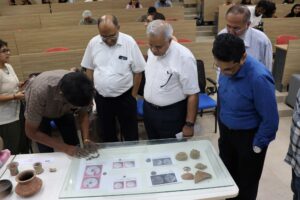Education
Mahindra University Symposium Explores Harappan Legacy and Its Quiet Influence on Modern Education
At a time when India is reflecting on 100 years since the discovery of the Indus Valley Civilisation, Mahindra University took a significant academic stride by hosting a landmark interdisciplinary symposium that not only honoured our ancient heritage but explored its forgotten links to modern education.
Organised as part of the university’s research initiative to decode the Indus script, the symposium brought together archaeologists, linguists, AI experts, and education scholars. It featured a stunning display of antiquities — including stone tools over 100,000 years old — and rare artefacts from the IVC, offering visitors a tangible glimpse into one of the world’s earliest urban cultures.

A Civilisation Ahead of Its Time
In her keynote, Dr Smita S. Kumar, Superintending Archaeologist at the Archaeological Survey of India, underscored the maritime trade and economic systems that made Harappa a powerhouse of cross-cultural exchange. “The legacy of Harappa shaped the economic landscape of the world and helped lay the foundation for global trade systems,” she said.
But beyond trade, the event also highlighted how the civilisation’s systems of standardisation, civic planning, and symbolism hinted at early forms of instruction and information dissemination.
Professor Yajulu Medury, Vice Chancellor of Mahindra University, stated, “This symposium underscores our commitment to interdisciplinary scholarship. Understanding the IVC helps us trace the evolution of knowledge systems in India.”
Indus Valley’s Forgotten Impact on Education
While IVC is not known for formal classrooms or textbooks, its influence on education is deeper than most realise. Their standardised brick sizes and sophisticated city layouts suggest a culture of measurement, geometry, and applied science. The presence of seals, the undeciphered script, and organised granaries all point to an inherent system of record-keeping and knowledge sharing — key elements of what education aims to do today.
Modern-day curriculum pillars like data literacy, urban planning, sustainable water management, and system design can all find philosophical and functional parallels in the Harappan way of life.
As India moves toward a more integrated and inclusive National Education Policy, perhaps it’s time we looked backward to move forward — and asked how much of our ancient knowledge systems still flow silently through our schools, textbooks, and educational practices.